Assessing the Geothermal Potential of a Fractured Carbonate Reservoir (Southern Apennines, Italy): Relationships Between Structural Control and Heat Flow
Abstract
1. Introduction
2. Geological Framework
3. Materials and Methods
3.1. Subsurface Data and Interpretation
3.2. Temperature Data
3.3. Velocity Model and Time–Depth Conversion
3.3.1. Allochthonous Input Parameters
3.3.2. Autochthonous Input Parameters
4. Results
4.1. 3D Geological Model
4.2. Comparison with Published Temperature, Surface Heat Flow Maps, and Deep Well Temperature Data
5. Discussion
5.1. Structural Model and the Propagation Velocity Approach
5.2. Temperature Gradient Variations Between the Structural Domains B and C
5.3. Geothermal Systems Within Structural Domains B and C
5.3.1. Heat Source
5.3.2. Heat Flux in the Reservoir
5.3.3. Fluid Source and Migration Pathway in and out Through the Geothermal Reservoir
5.3.4. Reservoir
5.3.5. Cap Rock—Thermal and Hydraulic Reservoir Insulation
5.4. Conceptual Geothermal Model
6. Conclusions
Supplementary Materials
Author Contributions
Funding
Data Availability Statement
Acknowledgments
Conflicts of Interest
Abbreviations
| AOI | Area of interest |
| BGL | Below ground level |
| MSL | Mean sea level |
| MPZ | Midpoint Z |
| TF | Thrust fault |
| BTF | Back-thrust fault |
| NF | Normal fault |
| SB | Structural block |
| HFM | Heat flow mechanism |
| CV | Convection |
| CD | Conduction |
| DST | Drill steam test |
| HC | Hydrocarbons |
| Vp | P-wave velocity |
| Vp/Vs | P-wave velocity and S-wave velocity ratio |
| TWT | Two–way time |
References
- ENEL Gren Power Home Page, Geothermal Energy in Italy: Where and How It Is Produced. Available online: https://www.enelgreenpower.com/learning-hub/renewable-energies/geothermal-energy/italy (accessed on 12 June 2025).
- Ministero dello Sviluppo Economico. Zonazione Geotermica del Territorio Italiano; Direzione Generale per la Sicurezza Anche Ambientale delle Attività Minerarie ed Energetiche–UNMIG: Roma, Italy, 2017; Available online: http://unmig.mise.gov.it/unmig/geotermia/zonazione.asp (accessed on 16 June 2025).
- Mazzoli, S. Geothermal Energy and Structural Geology. Energies 2022, 15, 8074. [Google Scholar] [CrossRef]
- Majorowicz, J. Review of the Heat Flow Mapping in Polish Sedimentary Basin across Different Tectonic Terrains. Energies 2021, 14, 6103. [Google Scholar] [CrossRef]
- Santini, S.; Basilici, M.; Invernizzi, C.; Mazzoli, S.; Megna, A.; Pierantoni, P.P.; Spina, V.; Teloni, S. Thermal Structure of the Northern Outer Albanides and Adjacent Adriatic Crustal Sector, and Implications for Geothermal Energy Systems. Energies 2020, 13, 6028. [Google Scholar] [CrossRef]
- Liotta, D.; Brogi, A.; Ruggieri, G.; Zucchi, M. Fossil vs. Active Geothermal Systems: A Field and Laboratory Method to Disclose the Relationships between Geothermal Fluid Flow and Geological Structures at Depth. Energies 2021, 14, 933. [Google Scholar] [CrossRef]
- Gudmundsson, A. Transport of Geothermal Fluids along Dikes and Fault Zones. Energies 2022, 15, 7106. [Google Scholar] [CrossRef]
- Enel: Inventario Delle Risorse Geotermiche Nazionali: Regione Campania. Rapporto Tecnico, (1987), 53pp., 8 tav. Disponibile sul sito Web dell’UNMIG, Ultimo. Available online: https://unmig.mase.gov.it/inventario-delle-risorse-geotermiche-nazionali-rapporti-regionali/ (accessed on 2 March 2022).
- Enel/Eni/Cnr/Enea: Inventario Delle Risorse Geotermiche Nazionali. Valutazione del Potenziale Geotermico Nazionale (1994). Aggiornamento 1994. Rapporto Tecnico, 194 pp., 6 tav. Disponibile Presso il sito web dell’UNMIG. Available online: https://unmig.mase.gov.it/inventario-delle-risorse-geotermiche-nazionali-rapporti-regionali/ (accessed on 2 March 2022).
- Botteghi, S.; Bruno, D.; Caielli, G.; Caiozzi, F.; Caputi, A.; Catalano, R.; Chiesa, S.; Contino, A.; D’Arpa, S.; De Alteriis, G.; et al. VIGOR: Sviluppo Geotermico Nelle Regioni Della Convergenza; CNR-IGG: Pisa, Italy, 2014; p. 161. ISBN 9788879580113. Available online: https://www.vigor-geotermia.it/images/download/volumi/VIGOR-Sviluppo-geotermico-regioni-convergenza.pdf (accessed on 2 March 2022).
- ViDEPI Project. Visibilità dei Dati Afferenti All’attività di Esplorazione Petrolifera in Italia; Ministero dello Sviluppo Economico, DGRME; Società Geologica Italiana; Assomineraria: Roma, Italy, 2009–2023; Available online: https://www.videpi.com/ViDEPI/ViDEPI.asp (accessed on 30 August 2024).
- Trumpy, E.; Manzella, A. Geothopica and the interactive analysis and visualization of the updated Italian National Geothermal Database. Int. J. Appl. Earth Obs. Geoinf. 2017, 54, 28–37. [Google Scholar] [CrossRef]
- Hippolyte, J.-C.; Angelier, J.; Roure, F. A major geodynamic change revealed by Quaternary stress patterns in the southern Apennines (Italy). Tectonophysics 1994, 230, 199–210. [Google Scholar] [CrossRef]
- Monaco, C.; Tortorici, L.; Paltrinieri, W. Structural evolution of the Lucanian Apennines, southern Italy. J. Struct. Geol. 1998, 20, 617–638. [Google Scholar] [CrossRef]
- Ferranti, L.; Oldow, J.S. Latest Miocene to Quaternary horizontal and vertical displacement rates during simultaneous contraction and extension in the Southern Apennines orogen, Italy. Terra Nova 2005, 17, 209–214. [Google Scholar] [CrossRef]
- Scrocca, D.; Sciamanna, S.; Di Luzio, E.; Tozzi, M.; Nicolai, C.; Gambini, R. Structural Setting along the CROP-04 Deep Seismic Profile (Southern Apennines-Italy). Boll. Soc. Geol. Ital. 2007, 7, 283–296. [Google Scholar]
- Brozzetti, F. The Campania-Lucania Extensional Fault System, Southern Italy: A Suggestion for a Uniform Model of Active Extension in the Italian Apennines. Tectonics 2011, 30, TC5009. [Google Scholar] [CrossRef]
- Patacca, E.; Scandone, P. Late Thrust Propagation and Sedimentary Response in the Thrust Belt-Foredeep System of the Southern Apennines. In Anatomy of an Orogen: The Apennines and Adjacent Mediterranean Basin; Vai, G.B., Martini, I.P., Eds.; Kluwer Academic Publishers: Dordrecht, The Netherlands, 2001; pp. 401–440. [Google Scholar]
- Scrocca, D. Southern Apennines: Structural Setting and Tectonic Evolution. J. Virtual Explor. 2010, 36, 14. [Google Scholar] [CrossRef]
- Shiner, P.; Beccacini, A.; Mazzoli, S. Thin-Skinned versus Thick-Skinned Structural Models for Apulian Carbonate Reservoirs: Constraints from the Val d’Agri Fields, S. Apennines, Italy. Mar. Pet. Geol. 2004, 21, 805–827. [Google Scholar] [CrossRef]
- Turrini, C.; Rennison, P. Structural Style from the Southern Apennines’ Hydrocarbon Province—An Integrated View. In Thrust Tectonics and Hydrocarbon Systems; McClay, K.R., Ed.; American Association of Petroleum Geologists: Tulsa, OK, USA, 2004; Volume 82, pp. 558–578. ISBN 978-0-89181-363-7. [Google Scholar]
- Vezzani, L.; Festa, A.; Ghisetti, F.C. Geology and Tectonic Evolution of the Central–Southern Apennines, Italy. In Geological Society of America Special Paper 469; Geological Society of America: Boulder, CO, USA, 2010; pp. 1–58. ISBN 978-0-8137-2469-0. [Google Scholar] [CrossRef]
- Patacca, E.; Scandone, P. Geology of the Southern Apennines. Boll. Soc. Geol. Ital. 2007, 7, 75–119. [Google Scholar]
- Scrocca, D.; Carminati, E.; Doglioni, C. Deep Structure of the Southern Apennines, Italy: Thin-skinned or Thick-skinned? Tectonics 2005, 24, 2004TC001634. [Google Scholar] [CrossRef]
- Menardi Noguera, A.; Rea, G. Deep Structure of the Campanian–Lucanian Arc (Southern Apennine, Italy). Tectonophysics 2000, 324, 239–265. [Google Scholar] [CrossRef]
- Mazzoli, S.; Corrado, S.; De Donatis, M.; Scrocca, D.; Butler, R.W.H.; Di Bucci, D.; Naso, G.; Scrocca, D.; Nicolai, C.; Zucconi, V. Time and Space Variability of “Thin-Skinned” and “Thick-Skinned” Thrust Tectonics in the Apennines (Italy). Rend. Lincei Sci. Fis. Nat. 2000, 11, 5–39. [Google Scholar] [CrossRef]
- Mazzoli, S. Subduction and Continental Collision Events in the Southern Apennines: Constraints from Two Crustal Cross-Sections. Rend. Online Soc. Geol. Ital. 2013, 25, 78–84. [Google Scholar] [CrossRef]
- Improta, L.; Corciulo, M. Controlled Source Non-Linear Tomography: A Powerful Tool to Constrain Tectonic Models of the Southern Apennines Orogenic Wedge, Italy. Geology 2006, 34, 941–944. [Google Scholar] [CrossRef]
- Nicolai, C.; Gambini, R. Structural Architecture of the Adria Platform-and-Basin System. Boll. Soc. Geol. Ital. 2007, 7, 21–37. [Google Scholar]
- Pace, P.; Di Cuia, R.; Mascolo, V. Revitalizing Exploration and Redevelopment of Deep Carbonate Targets in the Southern Apennines Thrust Belt (Southern Italy): Reappraising Vintage Data with Modern Approaches. Geol. Soc. Lond. Spec. Publ. 2020, 490, 221–240. [Google Scholar] [CrossRef]
- Ferranti, L.; Palano, M.; Cannavò, F.; Mazzella, M.E.; Oldow, J.S.; Gueguen, E.; Mattia, M.; Monaco, C. Rates of Geodetic Deformation across Active Faults in Southern Italy. Tectonophysics 2014, 621, 101–122. [Google Scholar] [CrossRef]
- Ferranti, L.; Carboni, F.; Akimbekova, A.; Ercoli, M.; Bello, S.; Brozzetti, F.; Bacchiani, A.; Toscani, G. Structural Architecture and Tectonic Evolution of the Campania-Lucania Arc (Southern Apennines, Italy): Constraints from Seismic Reflection Profiles, Well Data and Structural-Geologic Analysis. Tectonophysics 2024, 879, 230313. [Google Scholar] [CrossRef]
- Vitale, S.; Ciarcia, S. Tectono-Stratigraphic Setting of the Campania Region (Southern Italy). J. Maps 2018, 14, 9–21. [Google Scholar] [CrossRef]
- Feriozzi, F.; Improta, L.; Maesano, F.E.; De Gori, P.; Basili, R. The 3D Crustal Structure in the Epicentral Region of the 1980, Mw 6.9, Southern Apennines Earthquake (Southern Italy): New Constraints from the Integration of Seismic Exploration Data, Deep Wells, and Local Earthquake Tomography. Tectonics 2024, 43, e2023TC008056. [Google Scholar] [CrossRef]
- Castagna, J.P.; Batzle, M.L.; Kan, T.K. Rock Physics: The Link between Rock Properties and AVO Response. In Offset-Dependent Reflectivity–Theory and Practice of AVO Analysis; Castagna, J.P., Backus, M.M., Eds.; Investigations in Geophysics Society of Exploration Geophysicists: Houston, TX, USA, 1993; Investigations in Geophysics; Volume 8, pp. 135–171. [Google Scholar] [CrossRef]
- Gardner, G.H.F.; Gardner, L.W.; Gregory, A. Formation velocity and density—The diagnostic basics for stratigraphic traps. Geophysics 1974, 39, 770–780. [Google Scholar] [CrossRef]
- Robein, E. Velocities, Time-Imaging, and Depth-Imaging: Principles and Methods; EAGE Publications: Houten, The Netherlands, 2003; pp. 64–70. ISBN 978-90-73781-28-3. [Google Scholar]
- Tinitaly Official Home Page. Available online: https://tinitaly.pi.ingv.it/Download_Area1_1.html (accessed on 4 March 2022).
- Mostardini, F.; Merlini, S. Appennino Centro-Meridionale: Sezioni Geologiche e Proposta di Modello Strutturale. Mem. Soc. Geol. Ital. 1986, 35, 177–202. [Google Scholar]
- Casero, P.; Roure, F.; Muller, C.; Moretti, I.; Sage, L.; Vially, R. Evoluzione Geodinamica Neogenica dell’Appennino Meridionale. In L’Appennino Campano-Lucano nel Quadro Geologico dell’Italia Meridionale, Proceedings of the Atti del 74° Congresso della Società Geologica Italiana, Sorrento, Italy, 13–17 September 1988; Cocco, E., D’Argenio, B., Eds.; Scienze e Lettere S.r.l.: Roma, Italy, 1988; pp. 59–66. ISBN RMS 0058002. [Google Scholar]
- Patacca, E.; Scandone, P. Geological Interpretation of the CROP-04 Seismic Line (Southern Apennines, Italy). Boll. Soc. Geol. It. Spec. Issue 2007, 7, 297–315. [Google Scholar]
- Casciello, E.; Esestime, P.; Cesarano, M.; Pappone, G.; Snidero, M.; Vergés, J. Lower Plate Geometry Controlling the Development of a Thrust-Top Basin: The Tectonosedimentary Evolution of the Ofanto Basin (Southern Apennines). J. Geol. Soc. 2013, 170, 147–158. [Google Scholar] [CrossRef]
- Improta, L.; Iannaccone, G.; Capuano, P.; Zollo, A.; Scandone, P. Inferences on the Upper Crustal Structure of Southern Apennines (Italy) from Seismic Refraction Investigations and Subsurface Data. Tectonophysics 2000, 317, 273–298. [Google Scholar] [CrossRef]
- Di Bucci, D.; Massa, B.; Tornaghi, M.; Zuppetta, A. Structural Setting of the Southern Apennine Fold-and-Thrust Belt (Italy) at Hypocentral Depth: The Calore Valley Case History. J. Geodyn. 2006, 42, 175–193. [Google Scholar] [CrossRef]
- Butler, R.W.H.; Mazzoli, S.; Corrado, S.; De Donatis, M.; Di Bucci, D.; Gambini, R.; Naso, G.; Nicolai, C.; Scrocca, D.; Shiner, P.; et al. Applying Thick-Skinned Tectonic Models to the Apennine Thrust Belt of Italy—Limitations and Implications. In Thrust Tectonics and Hydrocarbon Systems; McClay, K.R., Ed.; AAPG Memoir: Tulsa, OK, USA, 2004; Volume 82, pp. 647–667. [Google Scholar]
- ISPRA, ENI, OGS. Digital Gravimetric Cartography of Italy at A Scale of 1:250,000. 2009. Available online: https://www.isprambiente.gov.it/it/progetti/cartella-progetti-in-corso/suolo-e-territorio-1/cartografia-gravimetrica-digitale (accessed on 10 March 2022).
- INGV Official Home Page. Available online: https://terremoti.ingv.it/en (accessed on 16 February 2022).
- Vannoli, P.; Bernardi, F.; Palombo, B.; Vannucci, G.; Console, R.; Ferrari, G. New Constraints Shed Light on Strike-Slip Faulting beneath the Southern Apennines (Italy): The 21 August 1962 Irpinia Multiple Earthquake. Tectonophysics 2016, 691, 375–384. [Google Scholar] [CrossRef]
- Kelemework, Y.; Milano, M.; La Manna, M.; de Alteriis, G.; Iorio, M.; Fedi, M. Crustal Structure in the Campanian Region (Southern Apennines, Italy) from Potential Field Modelling. Sci. Rep. 2021, 11, 14510. [Google Scholar] [CrossRef]
- Akimbekova, A.; Mancinelli, P.; Pozo, M.; Pauselli, C.; Minelli, G.; Barchi, M.R. Forward Modelling of Bouguer Anomalies along a Transect of the Southern Apennines and the Southern Tyrrhenian Sea (Italy). Ital. J. Geosci. 2021, 140, 411–421. [Google Scholar] [CrossRef]
- Bello, S.; de Nardis, R.; Scarpa, R.; Brozzetti, F.; Cirillo, D.; Ferrarini, F.; di Lieto, B.; Arrowsmith, R.J.; Lavecchia, G. Fault Pattern and Seismotectonic Style of the Campania–Lucania 1980 Earthquake (Mw 6.9, Southern Italy): New Multidisciplinary Constraints. Front. Earth Sci. 2021, 8, 608063. [Google Scholar] [CrossRef]
- Lavecchia, G.; Bello, S.; Andrenacci, C.; Cirillo, D.; Pietrolungo, F.; Talone, D.; Ferrarini, F.; Cascone, C.; D’Addezio, G.; De Donatis, M.; et al. QUIN 2.0–New Release of the QUaternary Fault Strain INdicators Database from the Southern Apennines of Italy. Sci. Data 2024, 11, 189. [Google Scholar] [CrossRef] [PubMed]
- Zarrouk, S.J.; McLean, K. Chapter 2: Geothermal Systems. In Geothermal Well Test Analysis: Fundamentals, Applications and Advanced Techniques; Academic Press: Oxford, UK, 2019; pp. 13–38. [Google Scholar]
- Italiano, F.; Martelli, M.; Martinelli, G.; Nuccio, P.M. Geochemical Evidence of Melt Intrusions along Lithospheric Faults of the Southern Apennines, Italy: Geodynamic and Seismogenic Implications. J. Geophys. Res. Solid Earth 2000, 105, 13569–13578. [Google Scholar] [CrossRef]
- Chiodini, G.; Granieri, D.; Avino, R.; Caliro, S.; Costa, A.; Minopoli, C.; Vilardo, G. Non-Volcanic CO2 Earth Degassing: Case of Mefite d’Ansanto (Southern Apennines), Italy. Geophys. Res. Lett. 2010, 37, L11304. [Google Scholar] [CrossRef]
- Turcotte, D.L.; Schubert, G. Geodynamics, 3rd ed.; Cambridge University Press: Cambridge, UK, 2014; pp. 105–120, 161–200, 201–230. [Google Scholar]
- Ingebritsen, S.E.; Sanford, W.E.; Neuzil, C.E. Groundwater in Geologic Processes, 2nd ed.; Cambridge University Press: Cambridge, UK, 2006; pp. 31–69, 95–125, 166–199. [Google Scholar]
- Grant, M.A.; Donaldson, I.G.; Bixley, P.F. Geothermal Reservoir Engineering; Academic Press: New York, NY, USA, 1982; pp. 25–65, 123–146. [Google Scholar]
- Lachenbruch, A.H.; Sass, J.H. Heat Flow in the United States and the Thermal Regime of the Crust; U.S. Geological Survey Professional Paper 1386; U.S. Government Printing Office: Washington, DC, USA, 1977; pp. 3–34, 55–72. [Google Scholar]
- Hochstein, M.P. Classification and Assessment of Geothermal Resources. In High Enthalpy Geothermal Resources: A Global Overview; United Nations University, Geothermal Training Programme: Reykjavik, Iceland, 1990; pp. 7–32. [Google Scholar]
- Ingebritsen, S.E.; Sanford, W.E. Groundwater in Geologic Processes; Cambridge University Press: Cambridge, UK, 1998; pp. 31–69, 166–199. [Google Scholar]
- Dickson, M.H.; Fanelli, M. Geothermal Energy: Utilization and Technology; Earthscan/UNESCO: London, UK, 2003; pp. 15–38. [Google Scholar]
- Della Vedova, B.; Bellani, S.; Pellis, G.; Squarci, P. Deep Temperatures and Surface Heat Flow Distribution. In Anatomy of an Orogen: The Apennines and Adjacent Mediterranean Basins; Vai, G.B., Martini, I.P., Eds.; Springer: Dordrecht, The Netherlands, 2001; pp. 65–76. [Google Scholar] [CrossRef]
- Moeck, I.S. Catalog of Geothermal Play Types Based on Geologic Controls. Renew. Sustain. Energy Rev. 2014, 37, 867–882. [Google Scholar] [CrossRef]
- Inversi, B.; Scrocca, D.; Montegrossi, G.; Livani, M.; Petracchini, L.; Brandano, M.; Brilli, M.; Giustini, F.; Recanati, R.; Gola, G.; et al. 3D Geological Modelling of a Fractured Carbonate Reservoir for the Study of Medium Enthalpy Geothermal Resource in Southern Apennines (Campania Region, Italy). In Proceedings of the European Geothermal Congress, Pisa, Italy, 3–8 June 2013; pp. 3–7. [Google Scholar]
- Amoresano, A.; Angelino, A.; Anselmi, M.; Bianchi, B.; Botteghi, S.; Brandano, M.; Brilli, M.; Bruno, P.P.; Caielli, G.; Caputi, A.; et al. VIGOR: Sviluppo geotermico nella regione Campania-Studi di Fattibilità a Mondragone e Guardia Lombardi. In Progetto VIGOR-Valutazione del Potenziale Geotermico delle Regioni della Convergenza, POI Energie Rinnovabili e Risparmio Energetico 2007–2013; CNR-IGG: Pisa, Italy, 2015; ISBN 9788879580151. Available online: www.vigor-geotermia.it/images/download/fatt_volumi/CAMPANIA/Campania.pdf (accessed on 2 March 2022).
- Livani, M.; Inversi, B.; Montegrossi, G.; Petracchini, L.; Alimonti, C.; Scrocca, D. Reusing Oil and Gas Exploration Data to Derisk Geothermal Projects: The Guardia Lombardi Case Study (Southern Italy). Renew. Energy 2025, 242, 122401. [Google Scholar] [CrossRef]
- Frottier, L.; Milesi, G.; Roche, V.; Duwiquet, H.; Taillefer, A. Heat Flow, Thermal Anomalies, Tectonic Regimes and High-Temperature Geothermal Systems in Fault Zones. Compt. Rendus Geosci. 2023, 356 (Suppl. 2), 389–421. [Google Scholar] [CrossRef]
- Questiaux, J.-M.; Couples, G.D.; Ruby, N. Fractured Reservoirs with Fracture Corridors. Geophys. Prospect. 2010, 58, 279–295. [Google Scholar] [CrossRef]
- Jolie, E.; Scott, S.; Faulds, J.; Chambefort, I.; Axelsson, G.; Gutiérrez-Negrín, L.C.; Regenspurg, S.; Ziegler, M.; Ayling, B.; Richter, A. Geological Controls on Geothermal Resources for Power Generation. Nat. Rev. Earth Environ. 2021, 2, 324–339. [Google Scholar] [CrossRef]
- Fadel, M.; Meneses Rioseco, E.; Bruna, P.-O.; Moeck, I. Pressure Transient Analysis to Investigate a Coupled Fracture Corridor and a Fault Damage Zone Causing an Early Thermal Breakthrough in the North Alpine Foreland Basin. Geoenergy Sci. Eng. 2023, 229, 212072. [Google Scholar] [CrossRef]
- Improta, L.; De Gori, P.; Chiarabba, C. New Insights into Crustal Structure, Cenozoic Magmatism, CO2 Degassing, and Seismogenesis in the Southern Apennines and Irpinia Region from Local Earthquake Tomography. J. Geophys. Res. Solid Earth 2014, 119, 8283–8311. [Google Scholar] [CrossRef]
- Vitagliano, E.; Improta, L.; Pizzino, L.; D’Agostino, N. Study of Well Data Reveals Fluid Pressure Distribution and Origin in the Upper Crust of the Irpinia Region (Southern Apennines, Italy). Tectonophysics 2025, 908, 230761. [Google Scholar] [CrossRef]
- Amoroso, O.; Ascione, A.; Mazzoli, S.; Virieux, J.; Zollo, A. Seismic Imaging of a Fluid Storage in the Actively Extending Apennine Mountain Belt, Southern Italy. Geophys. Res. Lett. 2014, 41, 3802–3809. [Google Scholar] [CrossRef]
- Amoroso, O.; Russo, G.; De Landro, G.; Zollo, A.; Garambois, S.; Mazzoli, S.; Parente, M.; Virieux, J. From Velocity and Attenuation Tomography to Rock Physical Modeling: Inferences on Fluid-driven Earthquake Processes at the Irpinia Fault System in Southern Italy. Geophys. Res. Lett. 2017, 44, 6752–6760. [Google Scholar] [CrossRef]
- De Landro, G.; Amoroso, O.; Russo, G.; D’Agostino, N.; Esposito, R.; Emolo, A.; Zollo, A. Decade-Long Monitoring of Seismic Velocity Changes at the Irpinia Fault System (Southern Italy) Reveals Pore Pressure Pulsations. Sci. Rep. 2022, 12, 1247. [Google Scholar] [CrossRef]
- Chiodini, G.; Valenza, M.; Cardellini, C.; Frigeri, A. A New Web-Based Catalog of Earth Degassing Sites in Italy. Eos Trans. AGU 2008, 89, 341–342. [Google Scholar] [CrossRef]
- Robertson, C.E. Thermal Properties of Rocks; United States Department of the Interior Geological Survey: Reston, VA, USA, 1988. [Google Scholar]
- Matano, F.; Critelli, S.; Barone, M.; Muto, F.; Di Nocera, S. Stratigraphic and Provenance Evolution of the Southern Apennines Foreland Basin System during the Middle Miocene to Pliocene (Irpinia-Sannio Successions, Italy). Mar. Pet. Geol. 2014, 57, 652–670. [Google Scholar] [CrossRef]
- Collettini, C.; Cardellini, C.; Chiodini, G.; De Paola, N.; Holdsworth, R.E.; Smith, S.A.F. Fault weakening due to CO2 degassing in the Northern Apennines: Short- and long-term processes. In The Internal Structure of Fault Zones: Implications for Mechanical and Fluid-Flow Properties; Wibberley, C.A.J., Kurz, W., Imber, J., Holdsworth, R.E., Collettini, C., Eds.; Geological Society, London, Special Publications: London, UK, 2008; Volume 299, pp. 175–194. [Google Scholar] [CrossRef]
- Trippetta, F.; Collettini, C.; Barchi, M.R.; Lupattelli, A.; Mirabella, F. A multidisciplinary study of a natural example of a CO2 geological reservoir in central Italy. Int. J. Greenh. Gas Control 2013, 12, 72–83. [Google Scholar] [CrossRef]
- Vannoli, P.; Martinelli, G.; Valensise, G. The Seismotectonic Significance of Geofluids in Italy. Front. Earth Sci. 2021, 9, 579390. [Google Scholar] [CrossRef]
- Rosenbaum, G.; Piana Agostinetti, N. Crustal and upper mantle responses to lithospheric segmentation in the northern Apennines. Tectonics 2015, 34, 648–661. [Google Scholar] [CrossRef]
- Italiano, F.; Martinelli, G.; Plescia, P. CO2 degassing over seismic areas: The role of mechanochemical production at the study case of Central Apennines. In Terrestrial Fluids, Earthquakes and Volcanoes: The Hiroshi Wakita Volume III. Pageoph Topical Volumes; Pérez, N.M., Gurrieri, S., King, C.Y., Taran, Y., Eds.; Birkhäuser: Basel, Switzerland, 2008; pp. 75–94. [Google Scholar]
- Chiodini, G.; Cardellini, C.; Amato, A.; Boschi, E.; Caliro, S.; Frondini, F.; Ventura, G. Carbon dioxide Earth degassing and seismogenesis in central and southern Italy. Geophys. Res. Lett. 2004, 31, L07615. [Google Scholar] [CrossRef]
- Chiodini, G.; Frondini, F.; Kerrick, D.M.; Rogie, J.; Parello, F.; Peruzzi, L.; Zanzari, A.R. Quantification of deep CO2 fluxes from central Italy: Examples of carbon balance for regional aquifers and of soil diffuse degassing. Chem. Geol. 1999, 159, 205–222. [Google Scholar] [CrossRef]
- Ghisetti, F.; Vezzani, L. Normal faulting, transcrustal permeability and seismogenesis in the Apennines (Italy). Tectonophysics 2002, 348, 155–168. [Google Scholar] [CrossRef]

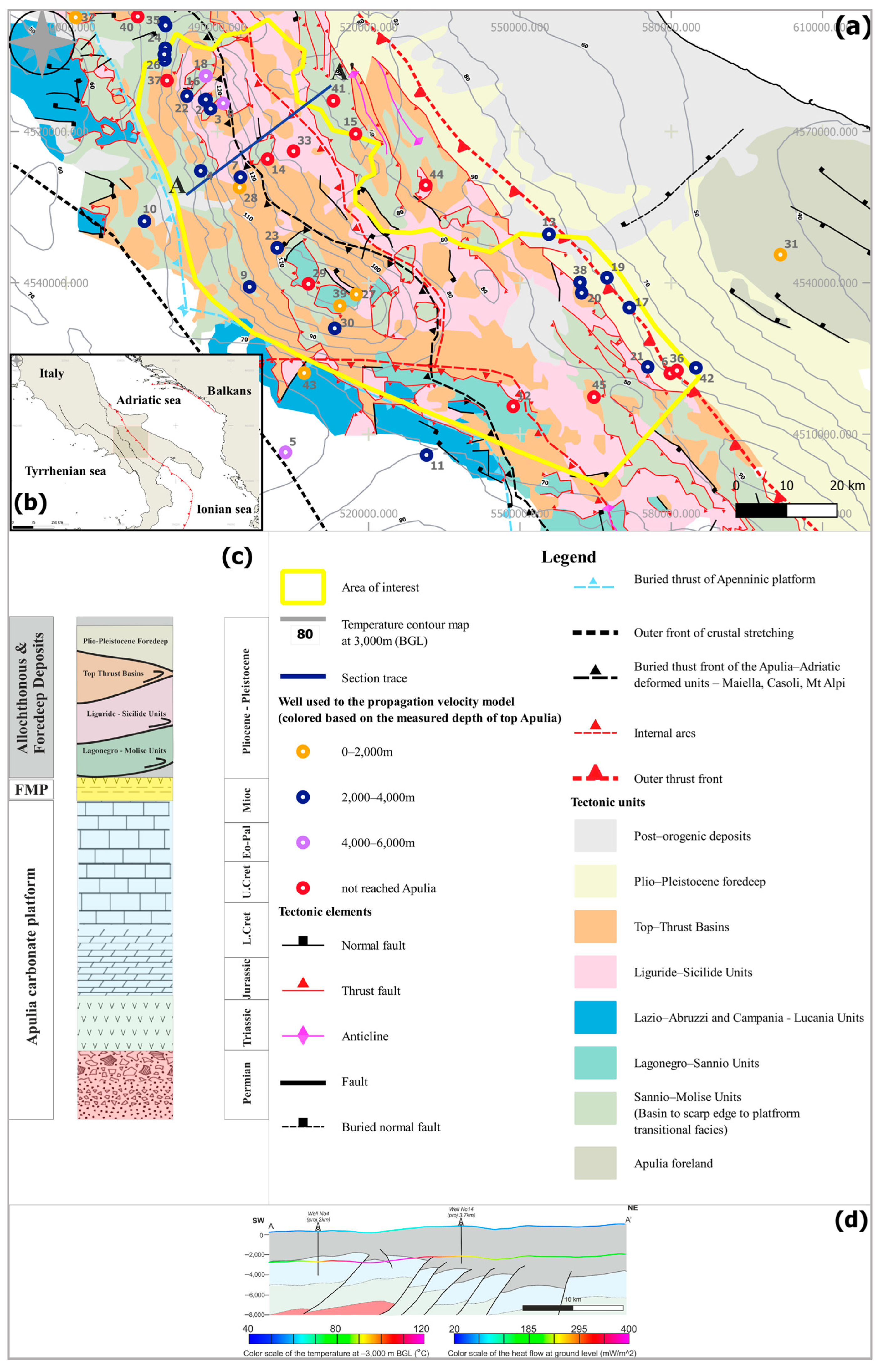


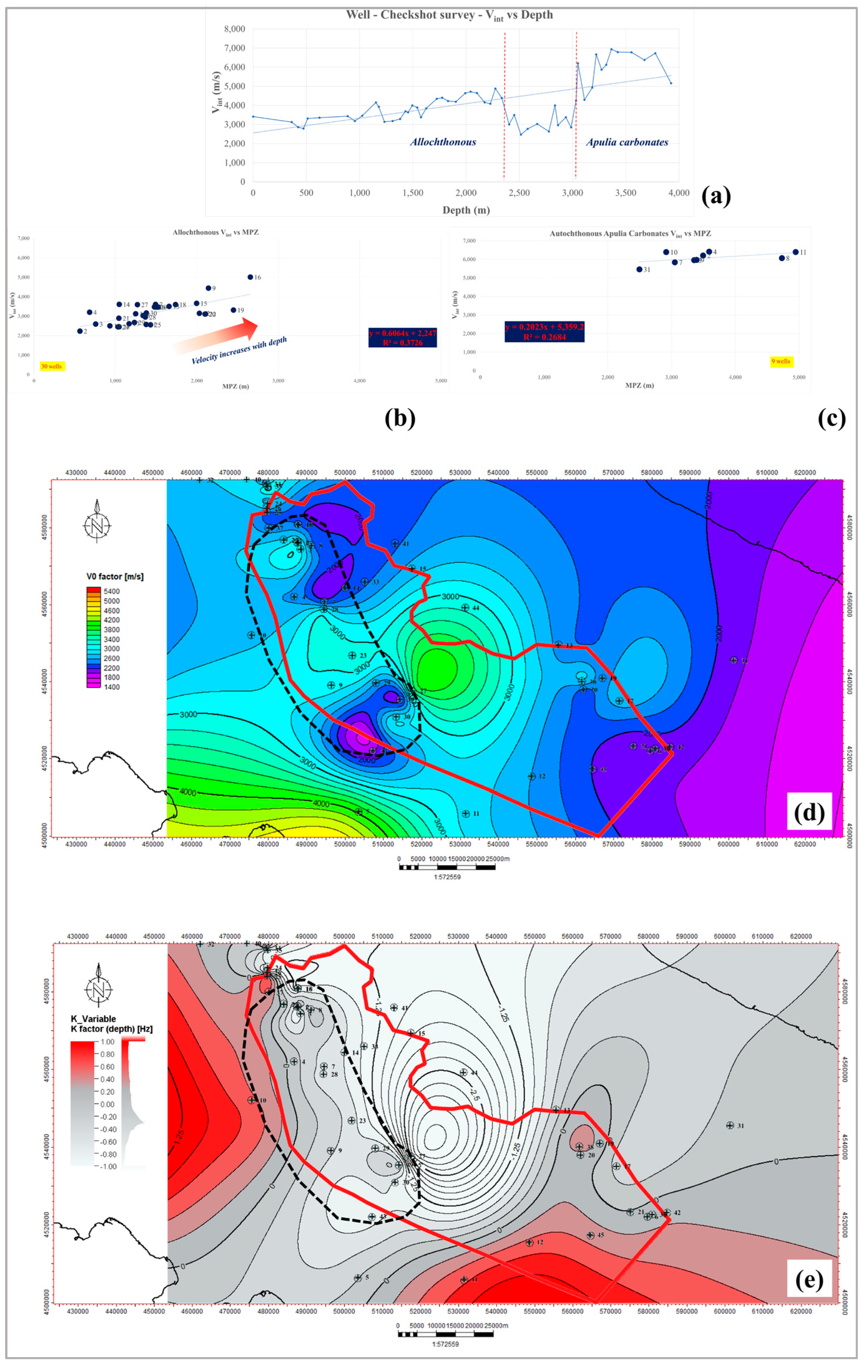
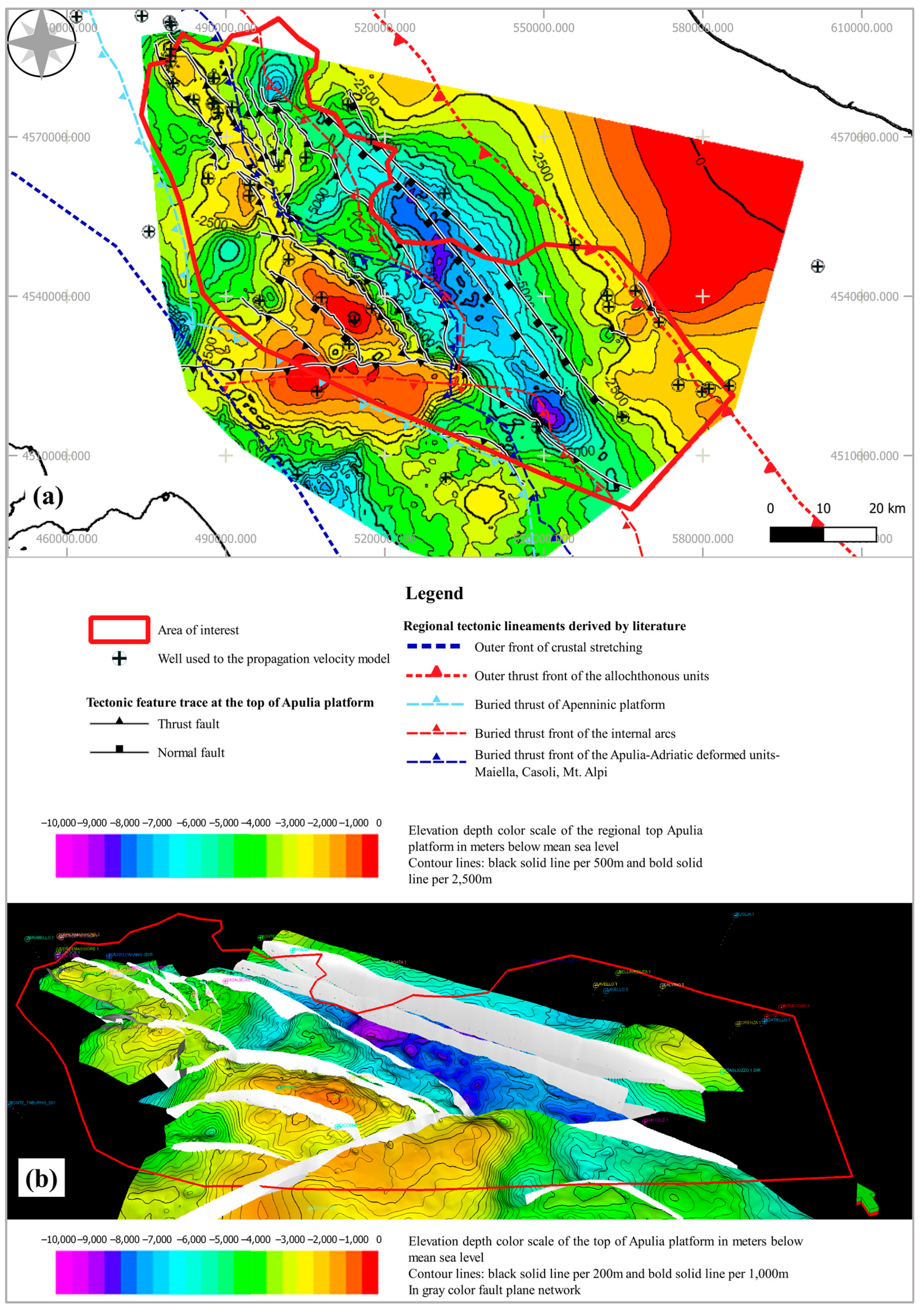

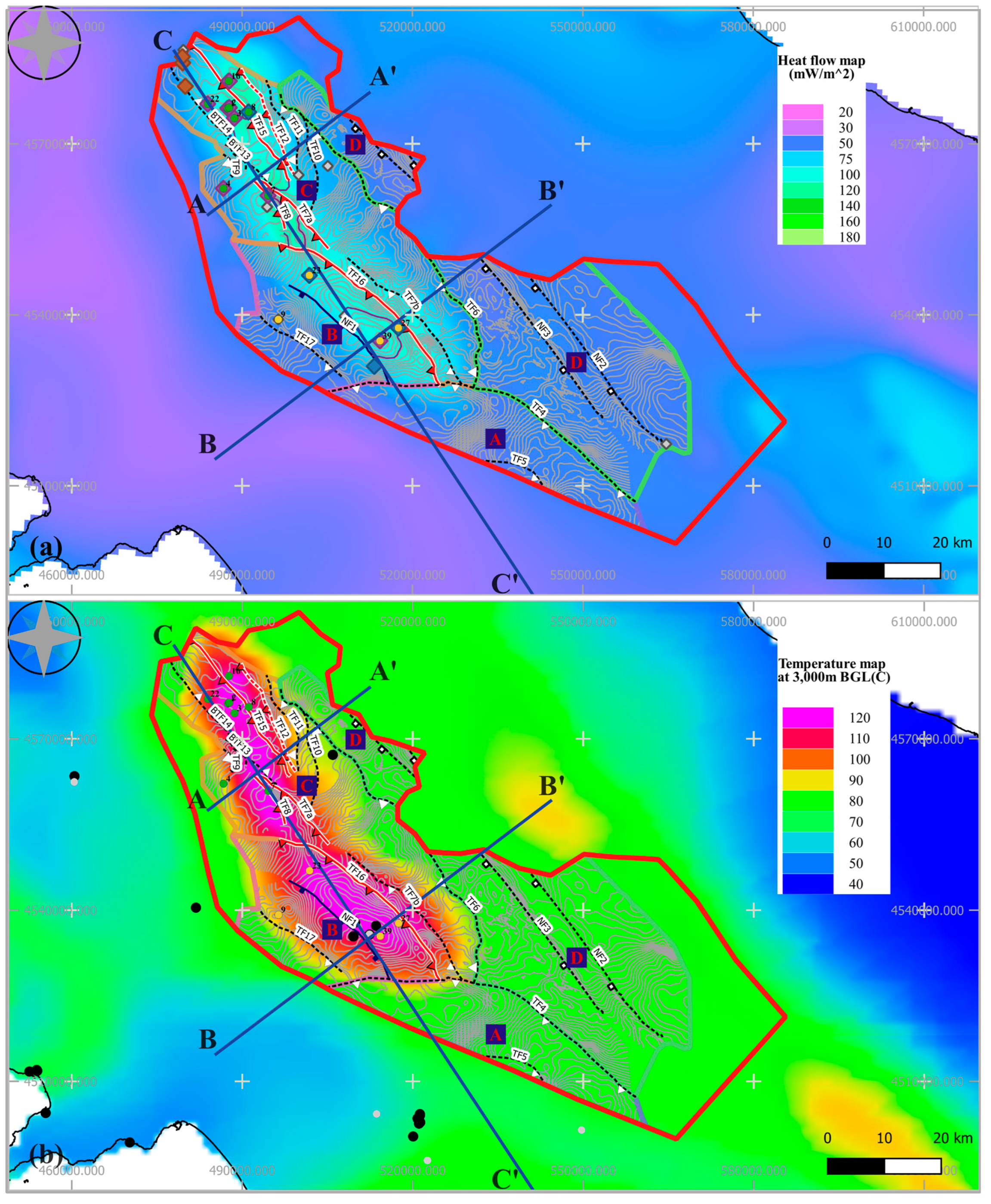
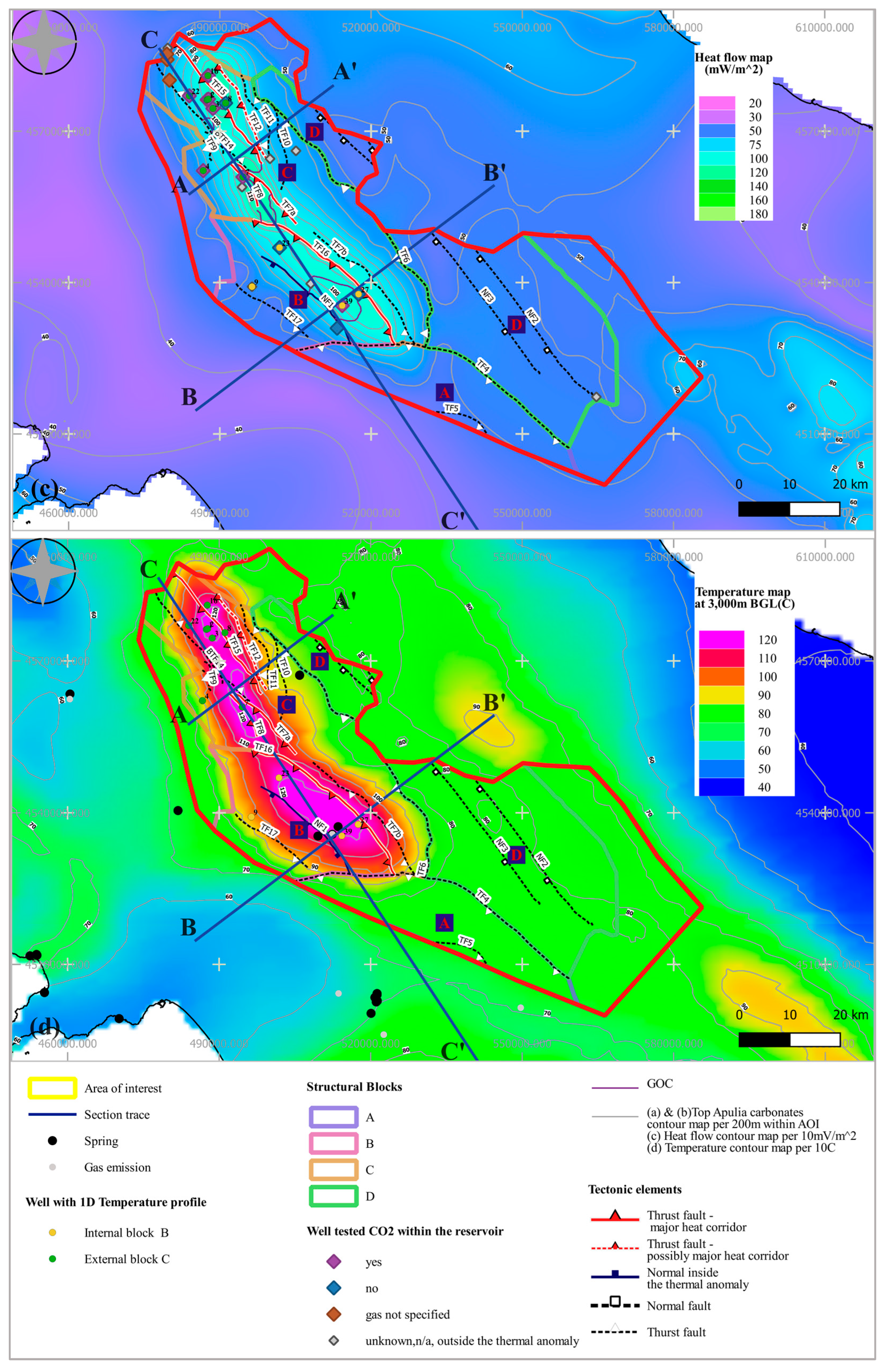
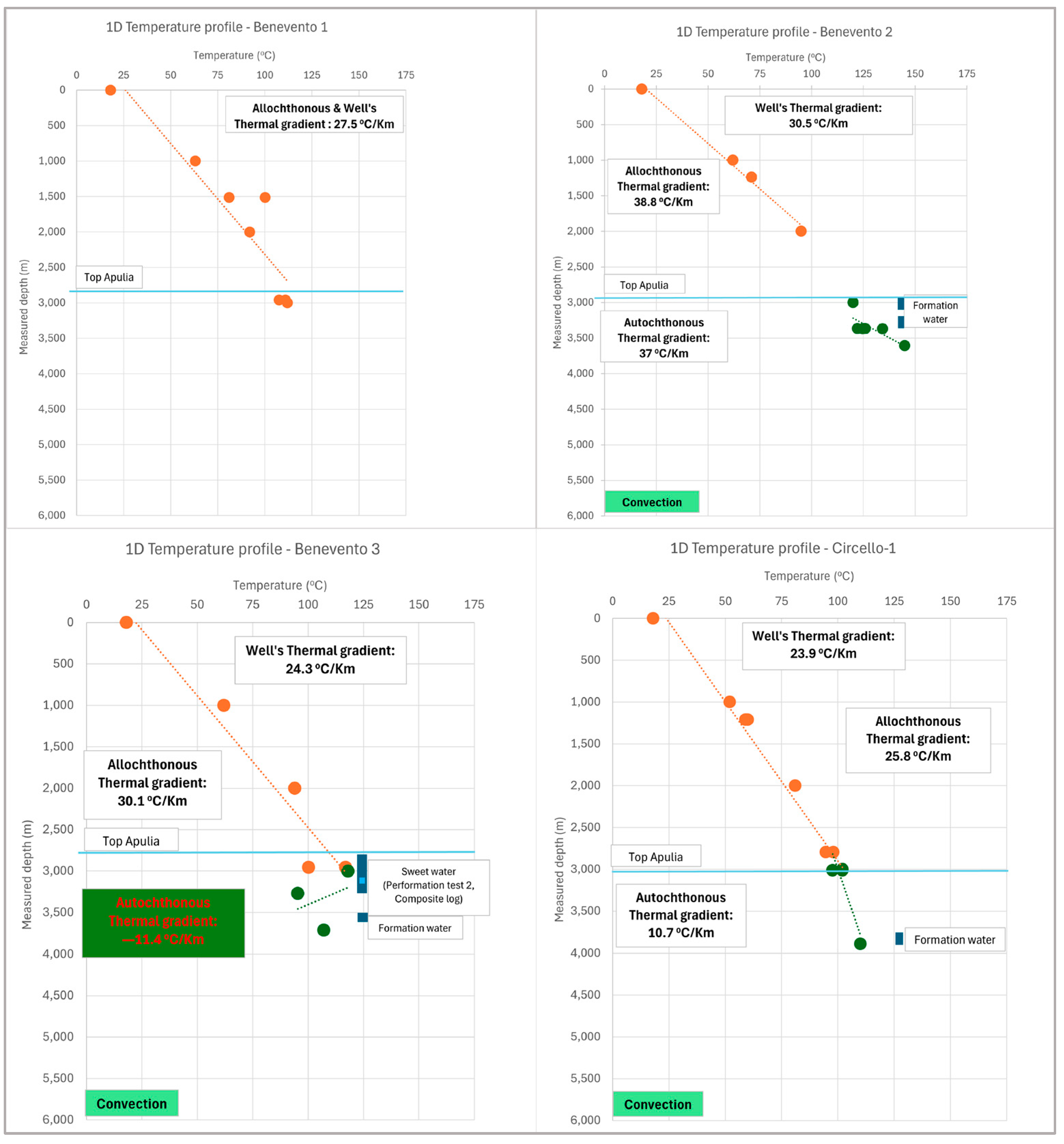




| Total Depth Max (m, BGL) | 0–2000 | 2000–4000 | 4000–6000 | 6000–8000 |
|---|---|---|---|---|
| Wells that drilled Apulia’s carbonate | 4 | 21 | 7 | 1 |
| Wells that did not reach Apulia’s carbonate | 4 | 5 | 3 | - |
| Measured Depth Reached Apulia Platform (m, BGL) | 0–2000 | 2000–4000 | 4000–6000 |
|---|---|---|---|
| Wells that drilled Apulia’s carbonate | 6 | 23 | 4 |
| Unit | Model | V0 (m/s) | K-Factor | Vint (m/s) | RMS Error | Source |
|---|---|---|---|---|---|---|
| Allochthonous | V0-k | V0 map | 0.39 | - | function depending on the well point | TD curves—30 wells inside and surrounding area |
| Carbonates of Apulia Platform | V0-k | 5400 | 0.2 | - | 26.80% | TD curves—9 wells inside and surrounding area |
| Triassic Burrano fm of Apulia platform | Vint | - | - | 6800 | - | TD curve—Puglia-1 well |
| Permian volcaniclastics of Apulia platform | Vint | - | - | 5200 | - | TD curve—Puglia-1 well |
| Well/Area | SB | Av. Th. Gradient (°C/km) | Cap Rock Thermal Gradient (°C/km) | Reservoir Thermal Gradient (°C/km) | Dif. Thermal Gradient Between Cap and Reservoir (°C/km) | HFM | Top Carbo Reservoir (m, BGL) | Temperature at the Top of the Reservoir (°C) | CO2 | HC | Meteoric H2O | Rank |
|---|---|---|---|---|---|---|---|---|---|---|---|---|
| Regional | - | 27.5 | 26.2 | 16.8 | 9.4 | CV | - | - | - | - | - | |
| Domain B | - | 28.5 | 31.7 | 16 | 15.7 | CV | - | - | - | - | - | |
| Domain C | - | 27.6 | 25.4 | 17.6 | 7.8 | CV | - | - | - | - | - | |
| Ben_1 | C | 27.5 | 27.5 | - | - | - | 2959 | 107–112 | yes | yes | no | 6(b) |
| Cast.Pag_1 | C | 22.5 | 22.9 | - | - | - | 4201 | 118–147 | yes | no | no | 10 |
| Ben_3 | C | 24.3 | 30.1 | −11 | 41.5 | CV | 2986 | 118 | yes | yes | yes | 7 |
| Bon_1Dir | B | 36.7 | 40.2 | 8 | 32.2 | CV | 2540 | 120 | no | no | no | 1 |
| Circ_1 | C | 23.9 | 25.8 | 10.7 | 15.1 | CV | 3002 | 97–102 | yes | no | no | 2 |
| M.For_1 | B | 35.6 | 44 | 31.5 | 12.5 | CV | 1128 | 62 | yes | no | yes | 9 |
| M.For_2 | B | 43.5 | 49 | 37.5 | 11.5 | CV | 1366 | 67 | no | no | no | 8 |
| Mol_Nord_1 | C | 25.2 | 25 | 18.5 | 6.5 | CV | 4063 | 136 | no | no | no | 5 |
| Taurasi_1 | B | 27.4 | 26.6 | 22 | 4.6 | CV | 3318 | 105 | no | no | no | 3 |
| Tranfaglia_1 | C | 34 | 36.9 | 34.9 | 2 | CV | 2756 | 121 | yes | no | no | 4 |
| Ben_2 | C | 30.5 | 38.8 | 37 | 1.8 | CV | 3050 | 120 | yes | yes | no | 6(a) |
| Ben_Sud_1 | C | 31.9 | 41.3 | 51.1 | −9.8 | CD | 2678 | 87 | yes | no | yes | - |
Disclaimer/Publisher’s Note: The statements, opinions and data contained in all publications are solely those of the individual author(s) and contributor(s) and not of MDPI and/or the editor(s). MDPI and/or the editor(s) disclaim responsibility for any injury to people or property resulting from any ideas, methods, instructions or products referred to in the content. |
© 2025 by the authors. Licensee MDPI, Basel, Switzerland. This article is an open access article distributed under the terms and conditions of the Creative Commons Attribution (CC BY) license (https://creativecommons.org/licenses/by/4.0/).
Share and Cite
Pontikou, C.; Vakalas, I.; Kokkalas, S.; Di Cuia, R.; Ricciato, A.; Toscani, G. Assessing the Geothermal Potential of a Fractured Carbonate Reservoir (Southern Apennines, Italy): Relationships Between Structural Control and Heat Flow. Geosciences 2025, 15, 311. https://doi.org/10.3390/geosciences15080311
Pontikou C, Vakalas I, Kokkalas S, Di Cuia R, Ricciato A, Toscani G. Assessing the Geothermal Potential of a Fractured Carbonate Reservoir (Southern Apennines, Italy): Relationships Between Structural Control and Heat Flow. Geosciences. 2025; 15(8):311. https://doi.org/10.3390/geosciences15080311
Chicago/Turabian StylePontikou, Chrysanthi, Ioannis Vakalas, Sotirios Kokkalas, Raffaele Di Cuia, Angelo Ricciato, and Giovanni Toscani. 2025. "Assessing the Geothermal Potential of a Fractured Carbonate Reservoir (Southern Apennines, Italy): Relationships Between Structural Control and Heat Flow" Geosciences 15, no. 8: 311. https://doi.org/10.3390/geosciences15080311
APA StylePontikou, C., Vakalas, I., Kokkalas, S., Di Cuia, R., Ricciato, A., & Toscani, G. (2025). Assessing the Geothermal Potential of a Fractured Carbonate Reservoir (Southern Apennines, Italy): Relationships Between Structural Control and Heat Flow. Geosciences, 15(8), 311. https://doi.org/10.3390/geosciences15080311






